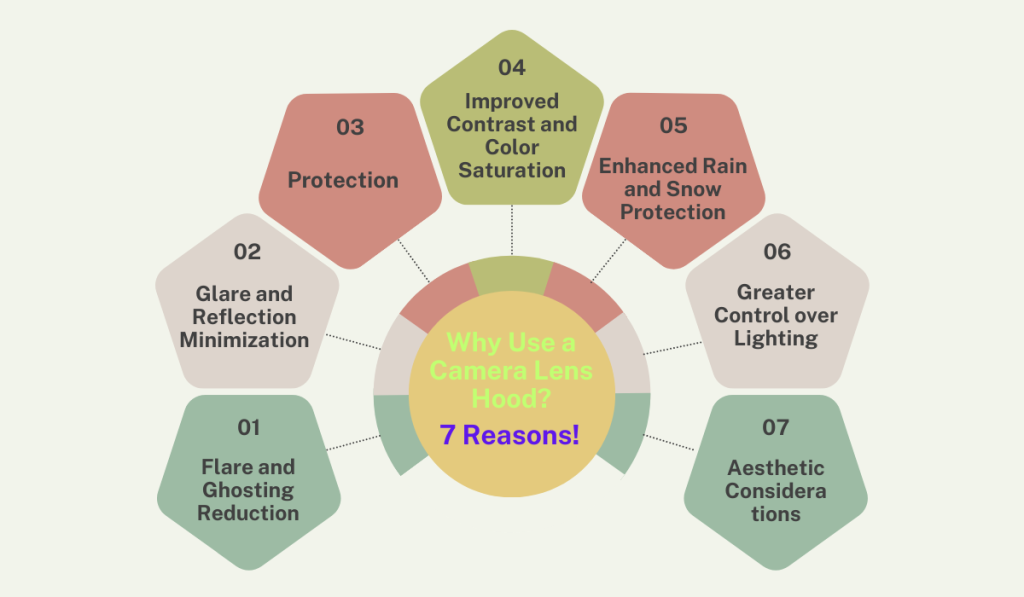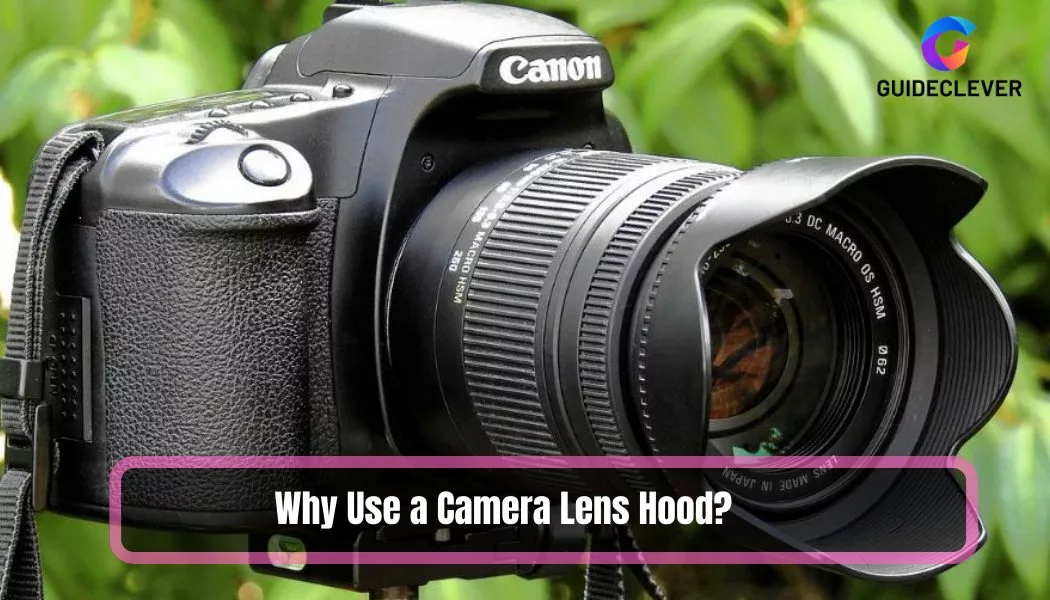Camera lens hoods are important accessories in photography. They are simple but valuable. Professional and amateur photographers use these tools to improve their photo quality. What is a camera lens hood and why do photographers find it essential?
Let’s talk about why using a camera lens hood is important. It improves image quality and prevents optical artifacts. It also helps you take beautiful, glare-free photos in different shooting conditions.
No matter if you’re experienced or new to photography, this little thing can greatly improve your pictures.
Contents
Why Use a Camera Lens Hood?

A camera lens hood is a useful accessory for photographers, and it serves several important purposes:
01. Flare and Ghosting Reduction:
One of the primary functions of a lens hood is to reduce the incidence of lens flare and ghosting in your photos. When light enters the lens, it creates flare which reduces contrast and image quality. A lens hood blocks stray light by shading the front element of the lens. This reduces or eliminates flare and ghosting.
02. Glare and Reflection Minimization:
When you take pictures in bright or sunny conditions, light can enter the lens from different angles. This can cause glare and reflections on the lens. A lens hood blocks light from the sides, making images clearer and more contrasty.
03. Protection:
Lens hoods also provide some physical protection to the front element of the lens. They can help shield the lens from accidental bumps, scratches, and minor impacts. This protection can be particularly valuable when shooting in outdoor or rugged environments.
04. Improved Contrast and Color Saturation:
By reducing the impact of stray light, a lens hood can help maintain the intended contrast and color saturation in your images. It is easy to see this when filming scenes with bright lights or contrasting colors.
05. Enhanced Rain and Snow Protection:
During bad weather, a lens hood can protect the lens from rain, snow, or debris, which could ruin the photos.
06. Greater Control over Lighting:
A lens hood allows you to have more control over the lighting in your composition. You can control the light that enters the lens by shading it from unwanted light sources.
07. Aesthetic Considerations:
You can use lens hoods creatively to add vignetting or slightly change your image’s aspect ratio. Many photographers use lens hoods to create a certain look or feel in their photos.
It's worth noting that while lens hoods are generally beneficial, there may be situations where you choose not to use one. For example, when using certain wide-angle lenses, the hood can cause vignetting (darkening of the corners of the image), so you may need to remove it in such cases. However, in most situations, using a lens hood is a good practice to improve the quality of your photographs.
Also Read: What Does a Lens Hood Do for a Camera: Lens Hood’s Impact!
Types of Camera Lens Hoods You Can Get
Here are a table for different types of camera lens hoods with there uses, ratings, prices and user feedback to help you choose one for your need:
| Types of Camera Lens Hood | Best Uses For | Ratings | Prices | User Feedback |
|---|---|---|---|---|
| Petal Lens Hood | Reduces lens flare | 4.5/5 | $15 – $40 | Positive: Blocks stray light effectively, Negative: Can be bulky. |
| Cylindrical Lens Hood | Reduces direct sunlight | 4.2/5 | $10 – $30 | Positive: Compact, Negative: Less effective in extreme conditions. |
| Flower Lens Hood | Reduces flare, vignetting | 4.6/5 | $20 – $50 | Positive: Reduces vignetting, Negative: Size can be a hindrance. |
| Rectangular Lens Hood | Eliminates rectangular glare | 4.3/5 | $15 – $35 | Positive: Reduces glare, Negative: Not as effective with wide angles. |
| Rubber Lens Hood | Flexible, versatile | 4.0/5 | $5 – $15 | Positive: Collapsible, Negative: Limited protection in harsh light. |
Please note that the ratings, prices, and user feedback can vary depending on the brand, size, and specific model of the lens hood.
When to Use a Camera Lens Hood?
A camera lens hood is a valuable accessory that should be used in specific situations to enhance the quality of your photographs. One of the primary purposes of a lens hood is to reduce lens flare and unwanted glare caused by stray light entering the lens.
You should use a lens hood when shooting in bright sunlight or with strong artificial lighting sources, as these conditions are more likely to produce glare or lens flare.
Lens hoods are helpful when taking outdoor pictures with wide-angle or telephoto lenses. They reduce unwanted artifacts in your images. But sometimes you don’t need a lens hood, like in a studio or with an incompatible hood.
When shooting, consider the conditions and lens type to decide if a lens hood helps. To improve your pictures, use a lens hood. It reduces optical effects and enhances colors and contrast.
How to Use Camera Lens Hood?
Using a camera lens hood is a straightforward process that can significantly improve the quality of your photographs by reducing lens flare and unwanted glare. Here’s a step-by-step guide on how to use a camera lens hood:
- Choose the Right Lens Hood: Ensure that you have the correct lens hood for your lens model and focal length.
- Attach the Lens Hood: Locate the mounting threads or bayonet mount on the front of your lens. The lens hood should have matching threads or a bayonet mount that fits onto your lens.
- Position the Hood Correctly: Most lens hoods have a petal-shaped or cylindrical design. For petal-shaped hoods, make sure that the petals or notches point upward and downward, not to the sides. For cylindrical hoods, position them so that they extend straight out from the lens.
- Adjust the Hood: Depending on the shooting angle and lighting conditions, you may need to adjust the angle of the lens hood.
- Check for Vignetting: When using wide-angle lenses or zooming out to a shorter focal length, be cautious of vignetting (dark corners in the frame).
- Remove the Lens Hood When Not Needed: In situations where the lens hood is not required, such as when shooting in a controlled studio environment or using a flash.
- Store the Lens Hood Safely: When not in use, store the lens hood in a safe place, such as a dedicated compartment in your camera bag or in a lens pouch. This helps protect it from damage and keeps it readily available when needed.
Using a camera lens hood is a simple yet effective way to enhance your photography by reducing lens flare and improving image contrast. By following these steps and adjusting the lens hood according to the shooting conditions, you can make the most of this essential accessory.
FAQ: Camera Lens Hood
Q1: Does a lens hood improve image quality?
A: Yes, a lens hood can improve image quality. Lens hoods are made to prevent lens flare and glare from stray light entering the lens. A lens hood helps make photos sharper and more vibrant by reducing optical artifacts.
Q2: Should I use a lens hood all the time?
A: While using a lens hood can be beneficial for most outdoor and well-lit shooting conditions, it’s not always necessary. In controlled environments like studios or when using a flash, a lens hood may not be needed. Additionally, some creative situations might call for lens flare or specific lighting effects. When deciding whether to use a lens hood, think about the lighting and your artistic goals.
Q3: Why use a camera lens hood Nikon (or any other brand)?
A: Using a camera lens hood, whether for Nikon or any other brand of camera, helps in reducing lens flare and glare, improving image quality. When you pick a lens hood, think about the lens, focal length, and shooting conditions. Nikon and other camera companies make lens hoods that work well with their lenses.
Q4: Petal vs. Cylindrical Lens Hood – Which is better?
A: The choice between a petal (also known as a tulip) and a cylindrical lens hood depends on your lens and shooting conditions. Hoods shaped like petals work well with wide-angle lenses. They shade effectively without causing vignetting. Cylindrical hoods are good for telephoto lenses and situations with less vignetting. The best choice depends on your lens and the photography you want to do. When choosing a hood, make sure it matches your lens and the shooting conditions you face.
Conclusion
To sum up, the camera lens hood is a small but important tool for photographers who want to improve their work. In photography, the lens filter is important. It reduces glare and makes images better. Photographers use lens hoods to block extra light from entering the lens and improve picture quality.
Whether you’re a pro or a fan, the lens hood helps you get amazing photos. It ensures your images shine with clarity and brilliance. Next time you use your camera, remember how important a lens hood can be for your photos.


